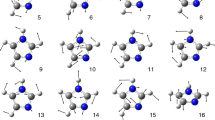Abstract
The kinetics of the thermal decomposition of square-planar complexes of the type Ni(NCS)2L2 (L=α-picoline; 2,6-lutidine and quinoline) was studied by following the loss of weight and using the isothermal method, in the temperature range of 72–147°. The reaction order found wasn=2/3; this together with macroscopic observations indicates that it is the proper chemical process which is the controlling factor of the total decomposition rate. The values of the activation energies decrease in the following order: Ni(NCS)2 Q2 > Ni(NCS)2(2,6-lut)2 > Ni(NCS)2(α-pic)2; this points to the reaction course according to the associative activation. Except for Ni(NCS)2Q2,ΔH was found to be >E a. This experimental result may be explained by a multi-step mechanism. Possible intermediates are discussed.
Résumé
On a étudié la cinétique de la décomposition thermique des complexes plans carrés du type Ni(NCS)2L2 (L=α-picoline, lutidine-2,6 et quinoléine) en enregistrant la perte de poids et en opérant en isotherme dans le domaine de température compris entre 72 et 147°. L'ordre de la réaction a été trouvé égal à 2/3; cette valeur et les observations macroscopiques indiquent que le processus chimique lui-même est le facteur principal qui influence la vitesse de la décomposition. Les valeurs des énergies d'activation diminuent dans l'ordre suivant: Ni(NCS)2Q2>Ni(NCS)2(lut-2,6)2 > Ni(NCS)2 (α-pic)2 ce qui apporte la preuve d'une réaction d'activation associative. On a trouvéΔH>E a sauf pour Ni(NCS)2Q2. On explique ce résultat par un mécanisme avec plusieurs étapes. Discussion des intermédiaires possibles.
Zusammenfassung
Man untersuchte durch Registrieren des Gewichtsverlustes und durch isotherme Methoden die Kinetik der thermischen Zersetzung der quadratischen Komplexe vom Typ Ni(NCS)2L2 (L=α-Pikolin, 2,6-Luthidin und Chinolin). Man fand die Reaktionsordnung fürn=2/3. Hieraus ergibt sich ergänzt durch bestimmende makroskopische Beobachtungen, daß der eigentliche chemische Prozeß der bestimmende Faktor für die totale Zersetzungsgeschwindigkeit ist. Die Aktivierungsenergiewerte vermindern sich in folgender Reihenfolge: Ni(NCS)2Q2 > Ni(NCS)2(2,6-lut)2 > Ni(NCS)2(α-pic)2; dies spricht für einen Reaktionsvorgang durch assoziative Aktivierung. Nur bei Ni(NCS)2Q2 wurdeΔH>E a gefunden. Dieser Befund kann durch einen Mehrschrittmechanismus erklärt werden. Mögliche Intermediäre wurden besprochen.
Резюме
Изучена кинетика тер мораспада комплексо в типа Ni(NCS)2L2 [L= α-пиколин, 2,6 лутидин и хинолин] пу тем измерения потери веса при использовании изоте рмического метода в области темп ератур 72–147°С. Рассчита нный порядок реакции раве н 2/3, что, наряду с макроскопич ескими наблюдениями, указывает на собственно химиче ский процесс, являющийся контроли рующим фактором скор ости полного распада. Величины энергии активации ум еньшаются в следующе м порядке: Ni(NCS)2Q2 > Ni(NCS)2 (2,6-лут.)2 > Ni(NCS)2(а-пик)2. Найдено откл онение для Ni(NCS)2Q2 иΔН >Е a. Этот результат объясняется многост упенчатым механизмо м. Возможные промежуточные проду кты обсуждаются.
Similar content being viewed by others
References
C. H. Langford andH. B. Gray, Ligand Substitution Processes, Benjamin, New York, 1965.
E. Jóna, Y. Jesenák, T. Šramko andJ. Gažo, Part C, J. Thermal. Anal., 5 (1973) 11.
E. Jóna, T. Šramko andJ. Gažo, Part A, J. Thermal Anal., 4 (1972) 61.
J. Zsakó, J. Phys. Chem., 72 (1968) 2406.
J. Šesták, Silikáty, 11 (1967) 153.
Š. Škramovský, R. Forster andG. F. Hüttig, Z. Phys. Chem. 25 (1934) 1.
G. F. Hüttig, Monatsh. Chem., 85 (1954) 376.
O. Levenspiel, Chemical Reaction Engineering, Wiley Interscience Publishers, New York, 1962. Czech. transi. “ Teorie a výpočty chemických reaktorov”. SNTL, Praha, 1967, 352.
E. Jóna, T. Šramko, P. Ambrovič andJ. Gažo, Part B, J. Thermal. Anal., 4 (1972) 153.
Author information
Authors and Affiliations
Rights and permissions
About this article
Cite this article
Jóna, E., JesenáK, V., Šramko, T. et al. Heterogeneous reactions of solid nickel(II) complexes, VI. Journal of Thermal Analysis 5, 389–396 (1973). https://doi.org/10.1007/BF01950229
Received:
Issue Date:
DOI: https://doi.org/10.1007/BF01950229




